parachute
 In every army, navy, and air force, there are exceptional soldiers…even among the enemy. During World War II, the German Luftwaffe had an incredible pilot. His name was Erich Rudorffer, and he is credited with shooting down thirteen Soviet aircraft in a single mission on October 11, 1943. In that historic mission while flying an FW-190, Rudorffer downed eight Yak-7s and five Yak-9s of the Soviet Air Force. He eventually shot down 222 enemy aircraft and ended up his combat career flying the Messerschmitt ME-262, the first operational jet fighter.
In every army, navy, and air force, there are exceptional soldiers…even among the enemy. During World War II, the German Luftwaffe had an incredible pilot. His name was Erich Rudorffer, and he is credited with shooting down thirteen Soviet aircraft in a single mission on October 11, 1943. In that historic mission while flying an FW-190, Rudorffer downed eight Yak-7s and five Yak-9s of the Soviet Air Force. He eventually shot down 222 enemy aircraft and ended up his combat career flying the Messerschmitt ME-262, the first operational jet fighter.
Still, it wasn’t just the number of planes he shot down that made him remarkable. It was also the fact that he managed to survive the war despite flying over 1000 missions and being shot down an incredible 16 times. He was even forced to parachute from his stricken fighter planes 9 of those times. Not just a Soviet killer, Rudorffer also shot down 86 aircraft operated by Western Allied air forces. He became a commercial pilot after World War II.
Rudorffer was born on November 1, 1917, in Zwochau, which was a part of the Kingdom of Saxony of the German Empire at that time. Strangely, or maybe not, very little is said or known about his parents. That was typical of the German leadership of that era. They felt like the state, and not the parents should raise the children, because…well, parents had no training in such things. Not that the German leadership did either, but they decided that they knew more than the parents, so they pulled the children from their parents’ homes and put them in boarding schools to “train” them in the German ways. After his graduation from school, Rudorffer received a vocational education as an automobile metalsmith specialized in coachbuilding, which was likely another of the German or “Nazi” way of deciding the course of the lives of the children. He might have stayed a mechanic were it not for World War I. “Rudorffer joined the military service of the Luftwaffe with Flieger-Ersatz-Abteilung 61 (Flier Replacement Unit 61) in Oschatz on April 16, 1936. From September 2 to October 15, 1936, he served with Kampfgeschwader 253 (KG 253—253rd Bomber Wing) and from October16, 1936 to February 24, 1937, he was trained as an aircraft engine mechanic at the Technische Schule Adlershof, the technical school at Adlershof in Berlin. On March 14, 1937, Rudorffer was posted to Kampfgeschwader 153 (KG 153—153rd Bomber Wing), where he served as a mechanic until end October 1938. After that, he was transferred to Flieger-Ersatz-Abteilung 51 (Flier Replacement Unit 51) based at Liegnitz in Silesia, present-day Legnica in Poland, for flight training. Rudorffer was first trained as a bomber pilot and then as a Zerstörer, a heavy fighter or destroyer, pilot. In the winter of 1944 Rudorffer was trained on the ME 262 jet fighter. In February 1945, he was recalled to command I. Gruppe JG 7 “Nowotny” from Major Theodor Weissenberger who replaced Steinhoff as Geschwaderkommodore. Rudorffer claimed 12 victories with the ME 262, to bring his total to 222. His tally 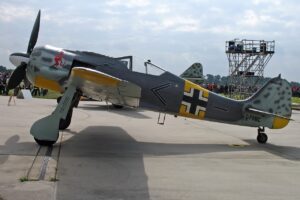 included 136 on the Eastern Front, 26 in North Africa, and 60 on the Western Front including 10 heavy bombers.”
included 136 on the Eastern Front, 26 in North Africa, and 60 on the Western Front including 10 heavy bombers.”
After the war ended, Rudorffer started out flying DC-2s and DC-3s in Australia. Later, he worked for Pan Am and the Luftfahrt-Bundesamt, Germany’s civil aviation authority. Rudorffer was honored as one of the characters in the 2007 Finnish war movie “Tali-Ihantala 1944.” A FW 190 participated, painted in the same markings as Rudorffer’s aircraft in 1944. The aircraft, now based at Omaka Aerodrome in New Zealand, still wears the colors of Rudorffer’s machine. Rudorffer died in April 2016 at the age of 98. At the time of his death, he was the last living recipient of the Knight’s Cross of the Iron Cross with Oak Leaves and Swords.

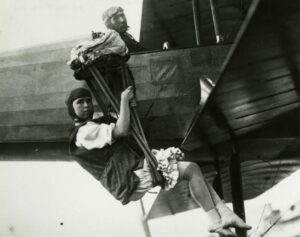 Personally, I see no reason to jump out of a perfectly good airplane, but I know that there are countless numbers of people who absolutely love the thrill of doing just that. In fact, before planes were invented there were parachutes. In 1783, gutsy inventor Louis-Sebastian Lourmand made the first-ever recorded successful parachute jump with a rigid-frame cloth parachute 14 feet in diameter. He, of course, jumped from a balloon, because there were no planes then. I can’t imagine how that jump went. The parachute was not soft and flexible, but rigid!! My mind can see so many things going wrong with that jump. In the early years of parachute jumping, the jumpers were men, because women were considered far too “fragile” and “delicate” for such activities, so I doubt if it would have even been allowed, had a woman asked.
Personally, I see no reason to jump out of a perfectly good airplane, but I know that there are countless numbers of people who absolutely love the thrill of doing just that. In fact, before planes were invented there were parachutes. In 1783, gutsy inventor Louis-Sebastian Lourmand made the first-ever recorded successful parachute jump with a rigid-frame cloth parachute 14 feet in diameter. He, of course, jumped from a balloon, because there were no planes then. I can’t imagine how that jump went. The parachute was not soft and flexible, but rigid!! My mind can see so many things going wrong with that jump. In the early years of parachute jumping, the jumpers were men, because women were considered far too “fragile” and “delicate” for such activities, so I doubt if it would have even been allowed, had a woman asked.
That all changed when a little woman named Georgia “Tiny” Broadwick came on the scene. Born to parents George and Emma Ross on April 8, 1893, Georgia Ann Thompson weighed about 3 pounds. She was the last of seven daughters, and because of her size, she was given the nickname “Tiny” since she weighed only 85 pounds and was 4 feet 8 inches tall, when she was fully grown. In those days, women often married very young, and at age 12, Tiny Broadwick had married and, at 13, had a daughter, Verla Jacobs (later, Poythress). By 15, Broadwick was abandoned by her husband and working in a cotton mill. It was then that she saw Charles Broadwick’s World Famous Aeronauts parachute from a hot air balloon. She was hooked and decided to join the travelling troupe. She left her daughter in the care of her parents. She later actually became Broadwick’s adopted daughter, to ease travel arrangements. Rumors also flew that she was his wife, but although her own family was later unclear on the relationship, that was not proven.
Although she would eventually make her jumps from airplanes, in her early career Broadwick jumped from balloons. Nevertheless, when the time came, Georgia “Tiny” Broadwick was not afraid, and she became the first woman to jump from an airplane too. She loved parachuting, and between 1913 and 1922 she completed over 1,100 jumps. Making that many jumps taught her that parachutes needed some improvements. So, she invented the ripcord, which is standard on every parachute to this day. Broadwick is also the only female member of the Early Birds of Aviation.
In 1914, she demonstrated parachutes to the US Army. At that time, the Army had a small fleet, but they were just as likely to crash as fly. I suppose that in that situation, knowing how to get out of the plane was crucial. Nevertheless, the Army was reluctant to adopt the parachute at first. They watched Tiny fearlessly dropped 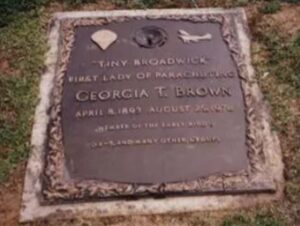
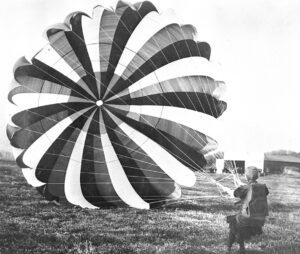 from the sky. Then, on one of her demonstration jumps, the static line became entangled in the tail assembly of the aircraft. As a solution, Tiny cut off the static line and deployed her chute manually on her next jump, thus becoming the first person to jump free-fall. This demonstrated that pilots could escape aircraft by using what was later called a ripcord, and for that she is now famous. Broadwick died in 1978 and was buried in Sunset Gardens in Henderson, North Carolina.
from the sky. Then, on one of her demonstration jumps, the static line became entangled in the tail assembly of the aircraft. As a solution, Tiny cut off the static line and deployed her chute manually on her next jump, thus becoming the first person to jump free-fall. This demonstrated that pilots could escape aircraft by using what was later called a ripcord, and for that she is now famous. Broadwick died in 1978 and was buried in Sunset Gardens in Henderson, North Carolina.
 Nine parachutes floated silently to the Earth on a calm February 27, 1943. Their mission was to blow up a Nazi-controlled heavy water plant in Vemork, Norway. The men had been specially trained by British Special Operations, and they had been chosen to carry out this vital mission. Heavy water was a crucial element in the production of plutonium, an ingredient for the nuclear bomb Hitler’s scientists were feverishly attempting to build. The plant at Vemork was the only such facility in the world.
Nine parachutes floated silently to the Earth on a calm February 27, 1943. Their mission was to blow up a Nazi-controlled heavy water plant in Vemork, Norway. The men had been specially trained by British Special Operations, and they had been chosen to carry out this vital mission. Heavy water was a crucial element in the production of plutonium, an ingredient for the nuclear bomb Hitler’s scientists were feverishly attempting to build. The plant at Vemork was the only such facility in the world.
The plant at Vemork was heavily fortified, and it remoteness made it impervious to bombing. It could only be destroyed on site, and for the men, parachuting in was just the beginning of the mission. The men would also be required to scale a 500-foot-high cliff in the dead of winter, and infiltrate a heavily guarded basement laboratory. The nine Norwegians, led by 23 year old Joachim Ronneborg, did just that, successfully detonating  explosives that shut down the facility. The destruction of the Vemork plant was crucial in Albert Speer’s decision to halt attempts to produce a Nazi atomic weapon.
explosives that shut down the facility. The destruction of the Vemork plant was crucial in Albert Speer’s decision to halt attempts to produce a Nazi atomic weapon.
The United States began early nuclear research first, but Germany was moving forward with its own nuclear energy research and atomic bomb program. In April 1939, Germany began a secret program called the Uranverein or “Uranium Club.” The German program recruited some of the top scientific minds in Germany, including recent Nobel Prize winner Werner Heisenberg. It was led by physicist Kurt Diebner. The Uranium Club was getting dangerously close to making an atomic weapon, and it had to be stopped. Hitler could not win this one.
Had nine Norwegian soldiers not trekked into the cold on that day in February 1943, it is hard to say how much 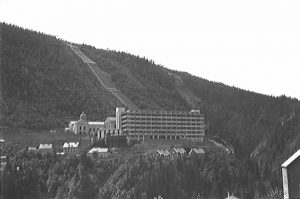 longer the war might have lasted, or how much destruction might have been carried out. Their brave and selfless act saved many lives to be sure. At the very least, Operation Gunnerside should be recognized as one of the most successful SOE missions during World War II. Ronneborg and his squad fully expected this mission to be a one-way trip. It never occurred to them that they might survive. Nevertheless, the operation brought with it zero casualties, and temporarily destroyed the Germans’ single source of heavy water at the time. Ronneborg later commented that “London could have suffered a different fate and ended up ‘looking like Hiroshima’ if his team had failed.”
longer the war might have lasted, or how much destruction might have been carried out. Their brave and selfless act saved many lives to be sure. At the very least, Operation Gunnerside should be recognized as one of the most successful SOE missions during World War II. Ronneborg and his squad fully expected this mission to be a one-way trip. It never occurred to them that they might survive. Nevertheless, the operation brought with it zero casualties, and temporarily destroyed the Germans’ single source of heavy water at the time. Ronneborg later commented that “London could have suffered a different fate and ended up ‘looking like Hiroshima’ if his team had failed.”

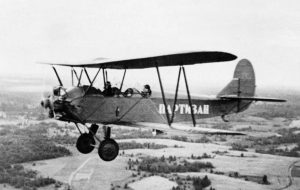 During and before World War II, and even after to a large degree, women were not allowed to hold combat positions, but the Soviets found that the enemy was fast encroaching on them, and there was no other choice. Using female bombardiers was even more undesirable, but Adolf Hitler had launched Operation Barbarossa, which was his massive invasion of the Soviet Union, in June 1941. By that autumn, the Germans were pressing on Moscow, Leningrad was under siege and the Red Army was struggling. The Soviets were desperate.
During and before World War II, and even after to a large degree, women were not allowed to hold combat positions, but the Soviets found that the enemy was fast encroaching on them, and there was no other choice. Using female bombardiers was even more undesirable, but Adolf Hitler had launched Operation Barbarossa, which was his massive invasion of the Soviet Union, in June 1941. By that autumn, the Germans were pressing on Moscow, Leningrad was under siege and the Red Army was struggling. The Soviets were desperate.
Marina Raskova, who was also known as the “Soviet Amelia Earhart,” had brainstormed the idea of a female squadron. She was famous not only as the first female navigator in the Soviet Air Force but also for her many long-distance flight records. Marina had been receiving letters from women all across the Soviet Union wanting to join the World War II war effort. Oh sure, they could go in as nurses, secretaries, or in some other support roles, but these women already knew how to fly. They had been training in air clubs all over the Soviet Union. They wanted to be gunners and pilots, flying on their own. Many of these women had lost brothers or boyfriends, and many had seen their homes and villages destroyed. Raskova petitioned Soviet dictator Joseph Stalin to let her form an all-female fighting squadron. Stalin wasn’t too keen on the idea, but it soon became apparent that they had no other choice.
On October 8, 1941, Stalin agreed to the plan and gave orders to deploy three all-female air force units. These women were going to be full-combat soldiers. They would not only fly missions and drop bombs, they would return fire too. With this action, the Soviet Union became the first nation to officially allow women to engage in combat. Previously, even women pilots could only help transfer planes and ammunition. Then, the men took over. Raskova quickly started to fill out her teams. She had more than 2,000 applications to choose from. She selected about 400 women for each of the three units. These were not long time pilots, but rather, most were students, ranging in age from 17 to 26. Those selected moved to Engels, a small town north of Stalingrad, to begin training at the Engels School of Aviation. The women underwent a highly compressed education, and were expected to learn in a few months what it took most soldiers several years to grasp. The only thing in their favor was that they already knew how to fly, just not in combat. Each recruit had to train and perform as pilots, navigators, maintenance and ground crew. Then the positions were assigned. The women faced skepticism from most of the male military personnel who believed they added no value to the combat effort, and called them “princesses.” Raskova did her best to prepare her women for these attitudes, but they still faced sexual harassment, long nights, and grueling conditions. “The men didn’t like the ‘little girls’ going to the front line. It was a man’s thing.” Assigned Polikarpov Po-2 biplanes, which was a bare-bones plywood biplane, the women flew under the cover of night. These light two-seater, open-cockpit planes were never meant for combat, and were often referred to as “a coffin with wings.” Made out of plywood with canvas pulled over, the aircraft offered virtually no protection from the elements. Flying at night, pilots endured freezing temperatures, wind, and frostbite. In the harsh Soviet winters, the planes became so cold, touching them caused skin to stick and rip off. They were given uniforms handed down from the men, and boots that were too big, and had to have the toes stuffed, so they would not slip.
In the air, they braved bullets and frostbite, while on the ground, they battled skepticism and sexual harassment. Nevertheless, in the air, they were so feared and hated by the Nazis that any German airman who downed one of these planes was automatically awarded the prestigious Iron Cross medal. All told, the unique all-female 588th Night Bomber Regiment dropped more than 23,000 tons of bombs on Nazi targets. And in doing so, they became a crucial Soviet asset in winning World War II. The Germans nicknamed them the Nachthexen, or “night witches,” because the whooshing noise their wooden planes made resembled that of a sweeping broom. “This sound was the only warning the Germans had. The planes were too small to show up on radar, or on infrared locators,” said Steve Prowse, author of the screenplay The Night Witches, a nonfiction account of the little-known female squadron. “They never used radios, so radio locators couldn’t pick them up either. They were basically ghosts.”
Due to both the planes’ limited weight capacity and the military’s limited funds, the female pilots didn’t have some of the basic necessities. Parachutes were deemed a “luxury” item. The added weight was just too much. They also didn’t have radar, guns, and radios. They were forced to use more rudimentary tools such as rulers, stopwatches, flashlights, pencils, maps, and compasses. Because these planes flew slower than the stall speed of the Nazi planes, they were very good at maneuvering out of the way of the German planes, making them hard to target. They also could easily take off and land from most locations. Still, there was a downside too. Whenever they did come under enemy fire, the pilots had to duck by sending their planes into dives, because most of them carried no defense ammunition. If they were hit by tracer bullets, which carry a pyrotechnic charge, the wooden planes would burst into flames, killing the crew.
One of the biggest drawbacks was that the Polikarpovs could only carry two bombs at a time…one under each wing. Two bombs per plane was not going to make much of a dent in the German targets, so the regiment sent out up to 40 two-person crews a night. Each would fly between 8 and 18 missions a night, returning to base to re-arm between runs. The weight of the bombs forced them to fly at lower altitudes, making them a much easier target, which is why they only flew missions at night. Each mission found the planes traveling in packs. The first planes were used as bait. Their job was to attract German spotlights, which provided the pack with much needed illumination. These bait-planes, rarely had ammunition to defend themselves. They would release a flare to light up the intended target. The last plane would idle its engines and glide in darkness to the bombing area. It was this “stealth mode” that created their signature witch’s broom sound. While these women were a formidable foe, they were also women. The Night Witches followed 12 commandments, the first of which was “be proud you are a woman.” They might be fierce killers of the Germans, but in their downtime they were still women. They did needlework, patchwork, decorated their planes and danced. They even put the pencils they used for navigation into double duty as eyeliner.
The last flight of the Night Witches took place on May 4, 1945…when they flew within 37 miles of Berlin. Three days later, Germany officially surrendered. According to Prowse, “the Germans had two theories about why these women were so successful: They were all criminals who were masters at stealing and had been sent to the front line as punishment, or they had been given special injections that allowed them to see in the night,” both of these “theories” make me laugh, like the female pilots couldn’t be just that…excellent fighter pilots in their own right. Altogether these capable, albeit “crazy” heroines flew more than 30,000 missions, or about 800 per pilot and navigator. They lost a total of 30 pilots, and 24 of the flyers were awarded the title Hero of the Soviet Union. Marina Raskova, who had spearheaded the movement, died on January 4, 1943, when her plane was shot down on a mission very near the front line. Hers was the very first state funeral of World War II and 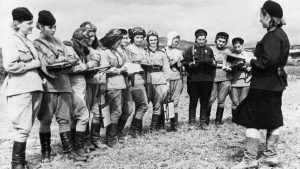
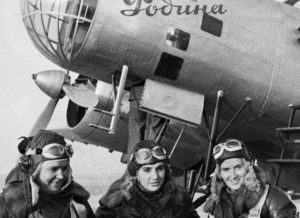 her ashes were buried in the Kremlin. The all-female 588th Night Bomber Regiment, despite being the most highly decorated unit in the Soviet Air Force during the World War II, was disbanded six months after the end of the war. When the big victory-day parade in Moscow was held, they weren’t included, because it was decided that their planes were too slow. Amazing!!!
her ashes were buried in the Kremlin. The all-female 588th Night Bomber Regiment, despite being the most highly decorated unit in the Soviet Air Force during the World War II, was disbanded six months after the end of the war. When the big victory-day parade in Moscow was held, they weren’t included, because it was decided that their planes were too slow. Amazing!!!
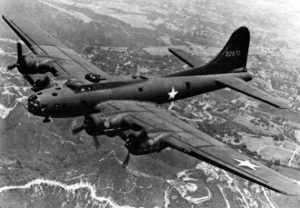 Strange things have been known to happen over the centuries of Earth’s existence. Most end up being clearly explained. Some are explained, but few people believe the explanation, and still others are forever mysteries…destined to have no possible explanation. People, especially those who witness the event, just know that it did happen. Often, wars are filled with strange stories. Everything from bombs killing everyone in an area, except for one lone old woman; to enemy soldiers allowing a soldier to go free, even though the enemy clearly had the upper hand. Of course, some mysteries defy any possible explanation. Such is the case of the Phantom Fortress. If one looks there can be found all manner of oddities and anomalies scattered in the background of the more sensational news of the fighting of a war, coming from land, air, and sea. From ghost ships found floating in the oceans years after they were last seen, their crews mysteriously missing, with no sign of violence or death on board. Of course, the stories run wild, sighting every possibility from UFOs; to disappearance to another dimension; to desertion, though hard to explain, when no trace of the crew ever showed up anywhere else. Still, few were more strange than the Phantom Fortress.
Strange things have been known to happen over the centuries of Earth’s existence. Most end up being clearly explained. Some are explained, but few people believe the explanation, and still others are forever mysteries…destined to have no possible explanation. People, especially those who witness the event, just know that it did happen. Often, wars are filled with strange stories. Everything from bombs killing everyone in an area, except for one lone old woman; to enemy soldiers allowing a soldier to go free, even though the enemy clearly had the upper hand. Of course, some mysteries defy any possible explanation. Such is the case of the Phantom Fortress. If one looks there can be found all manner of oddities and anomalies scattered in the background of the more sensational news of the fighting of a war, coming from land, air, and sea. From ghost ships found floating in the oceans years after they were last seen, their crews mysteriously missing, with no sign of violence or death on board. Of course, the stories run wild, sighting every possibility from UFOs; to disappearance to another dimension; to desertion, though hard to explain, when no trace of the crew ever showed up anywhere else. Still, few were more strange than the Phantom Fortress.
On November 23, 1944, a British Royal Air Force anti-aircraft unit stationed near Cortonburg, Belgium was suddenly surprised to see an American Army Air Corps B-17 bomber, nicknamed the “Flying Fortress,” heading in their direction. Because there was no such landing scheduled and because of the speed of the incoming aircraft it was assumed that it was preparing to make an emergency landing at the base. Still, after checking with the base tower, it was confirmed that that no such B-17 landing was expected. Be that as it may, this plane was coming in for a landing, so the gunner crew watched helplessly as the massive aircraft came hurtling in towards a nearby open, plowed field.
No matter what standards you use, this landing was a messy one to say the least. The plane bounced and swerved along as the terrified gunners looked on. It finally came to a stop dangerously close to their position after one of its wings clipped the ground. Nevertheless, it was still in one piece and had not actually crashed, but it was an incredibly rough landing. The stunned gunners watched as the aircraft sat there looming over the field, its propellers continuing to spin. The minutes ticked by, but no one exited the plane. After waiting 20 minutes with no sign of human activity, and the plane just sitting there with its engines running, the gunner crew decided to go in and investigate. They had no idea what kind of a scene awaited them inside, but what they found, they never could have guessed. Upon opening the entry hatch under the fuselage, they entered. The gunner crew expected that the crew had been injured or was otherwise unable to get out of the plane, but what they found was that the plane was completely empty. Unable to believe what they had just witnessed, especially in light of the empty plane, the gunner crew made a full sweep through the aircraft. The gunner crew reported that it looked like the crew had just recently been there and must have left the aircraft in a hurry. They found chocolate bars unwrapped and half eaten lying about, a row of neatly folded parachutes, with none apparently missing, and jackets that had been neatly hung up.
The superior officer, a John V. Crisp, would say of the eerie scene, “We now made a thorough search and our most remarkable find in the fuselage was about a dozen parachutes neatly wrapped and ready for clipping on. This made the whereabouts of the crew even more mysterious. The Sperry bomb-sight remained in the Perspex nose, quite undamaged, with its cover neatly folded beside it. Back on the navigator’s desk was the code book giving the colours and letters of the day for identification purposes. Various fur-lined flying jackets lay in the fuselage together with a few bars of chocolate, partly consumed in some cases.” Crisp found himself in an awkward position. He knew what he was seeing. He knew that he would have to write up the report on the incident. And most importantly, he knew that his men were looking to him for answers. Where had the crew of the “Phantom Fortress” gone and how had the plane landed on its own? This was not during a time when planes could be programed to land. No one had any idea how this could have come to pass. Crisp told the men to shut the engines down, and they inspected the planes interior further. The men looked for anything that might provide answers. The log book was found opened, and the last cryptic words written in it were “bad flak.” Yet, all of the parachutes seemed to be accounted for and the exterior of the plane did not have evidence of flak damage, or any damage except for what it had incurred in its rough landing, such as the buckled wing and one disabled engine. The log entry just seemed strange considering.
The B-17’s crew was eventually found, alive and well. For their side, they said, “They changed their course towards Brussels, Belgium, at the same time making the plane lighter by dumping and jettisoning any unnecessary or nonessential equipment on board. When the plane still continued to suffer and a second engine on the struggling plane sputtered out, it was decided that the aircraft would be unable to make the journey, and the crew had then decided to bail out. The B-17 was put on autopilot and left to its fate as the crew jumped to safety. No one thought it would make it very far, let alone somehow land, but land it did.” It seemed as if they honestly thought they had been in battle, and even more, that they had bailed out, with parachutes that were miraculously replaced. Still, why did ground crew report all 4 engines working as the bomber had approached, with one being damaged only upon landing, when the report said that 2 engines had been knocked out during the mission? Where was the damage from the claimed enemy fire? Perhaps most mysterious of all, how had a large, cumbersome plane like the B-17 manage to come to a landing without a pilot?
Authorities on the case, as well as crew members of the Phantom Fortress, suggested some theories to explain the mysteries surrounding the event. For instance, with the engines it could have been that the technical difficulties cleared up on their own after the crew had bailed out, making the plane seem to have 4 fully operating engines on approach, although why they would start working again after being taken out remains mysterious. If the engines had been in bad enough shape for the crew to abandon the aircraft it seems odd that they should kick back into working order on their own and continue whirring away even after the rough landing. As to the lack of any apparent visible damage from enemy fire, the gunner crew could have simply missed the damage due to the untrained eyes of the team that initially investigated the plane after it had landed. They were just a gunner crew, not trained aviators, and may have mistaken the damage reported by the B-17 crew as being from the crash. They might not have noticed that the aircraft had sustained battle damage, but then again they were anti-aircraft gunners and might have had some idea. With the parachutes, it was surmised that they had possibly mistaken some spare parachutes as the full compliment. However, this is all speculation, and the mystery has never been totally solved. Still, the biggest mystery simply cannot be explained away. How did the B-17 come to a landing mostly intact without a pilot? Autopilot is one thing, but landing is another beast altogether. As the saying goes, “Flying is easy, landing is hard.” A pilotless B-17 landing by itself with no one on board was unprecedented. It should have careened into the ground to crash into a ball of fire and debris, or at least ended up a heap of twisted wreckage. So how could this happen?
Although no one really knows for sure, the main theory is “that the plane simply lost altitude slowly, at just the right speed, and with just the right angle of descent to come down relatively softly enough to appear as if it was landing, with the B-17’s legendary toughness and sturdy frame managing to hold it together to keep it from disintegrating.” To this, I say, “Come on!! Get serious!!” The odds of all of this happening in just such a way is all but impossible. Also, there is the rather odd detail that this unmanned plane just happened to come 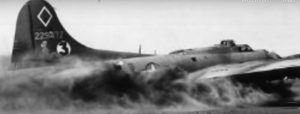 down in the exact best place to land under the circumstances, in that wide open field, and not one of the countless other places it could have come down more tragically. Its just too odd. Nevertheless, the mystery landing of the “Phantom Fortress” did happen. The details of how it did remain mysterious and open to speculation. What we do know for sure is that this B-17 was on a bombing mission in Germany, that it did land without a crew in that field, and that the crew members were later found to have been alive and well with quite a story to tell.
down in the exact best place to land under the circumstances, in that wide open field, and not one of the countless other places it could have come down more tragically. Its just too odd. Nevertheless, the mystery landing of the “Phantom Fortress” did happen. The details of how it did remain mysterious and open to speculation. What we do know for sure is that this B-17 was on a bombing mission in Germany, that it did land without a crew in that field, and that the crew members were later found to have been alive and well with quite a story to tell.
 Jumping out of a plane with a parachute, while not something I would consider doing, has become a favorite pastime for many people, but the original parachute jump was not from an airplane. The first noteworthy parachute jump was made by André-Jacques Garnerin from a hydrogen balloon 3,200 feet above Paris. Apparently, Leonardo da Vinci first conceived the idea of the parachute in his writings, and Frenchman, Louis-Sebastien Lenormand fashioned a kind of parachute out of two umbrellas and jumped from a tree in 1783. But, Garnerin was the first person to actually design and test parachutes capable of slowing a man’s fall from an altitude higher than a tree.
Jumping out of a plane with a parachute, while not something I would consider doing, has become a favorite pastime for many people, but the original parachute jump was not from an airplane. The first noteworthy parachute jump was made by André-Jacques Garnerin from a hydrogen balloon 3,200 feet above Paris. Apparently, Leonardo da Vinci first conceived the idea of the parachute in his writings, and Frenchman, Louis-Sebastien Lenormand fashioned a kind of parachute out of two umbrellas and jumped from a tree in 1783. But, Garnerin was the first person to actually design and test parachutes capable of slowing a man’s fall from an altitude higher than a tree.
I can almost hear the wheels turning in Garnerin’s head, as he first pondered the possibility of using air resistance to slow an individual’s fall from a high altitude, while he was a prisoner of war during the French Revolution. Although he never employed a parachute to escape from the high ramparts of the Hungarian prison where he spent three years, Garnerin never lost interest in the concept of the parachute. In 1797, he completed his first parachute, a canopy 23 feet in diameter and attached to a basket with suspension lines.
On October 22, 1797, Garnerin attached the parachute to a hydrogen balloon and ascended to an altitude of  3,200 feet. He then climbed into the basket and severed the parachute from the balloon. Parachutes need an air vent in the top, unbeknownst to Garnerin. As he failed to include said air vent at the top of the prototype, Garnerin’s parachute oscillated wildly in his descent. He landed shaken but unhurt half a mile from the balloon’s takeoff site. In 1799, Garnerin’s wife, Jeanne-Genevieve, became the first female parachutist. In 1802, Garnerin made a spectacular jump from 8,000 feet during an exhibition in England. He died in a balloon accident in 1823 while preparing to test a new parachute. I suppose it could be said that he died doing what he loved. Nevertheless, it would be an awful way to go, if you ask me.
3,200 feet. He then climbed into the basket and severed the parachute from the balloon. Parachutes need an air vent in the top, unbeknownst to Garnerin. As he failed to include said air vent at the top of the prototype, Garnerin’s parachute oscillated wildly in his descent. He landed shaken but unhurt half a mile from the balloon’s takeoff site. In 1799, Garnerin’s wife, Jeanne-Genevieve, became the first female parachutist. In 1802, Garnerin made a spectacular jump from 8,000 feet during an exhibition in England. He died in a balloon accident in 1823 while preparing to test a new parachute. I suppose it could be said that he died doing what he loved. Nevertheless, it would be an awful way to go, if you ask me.

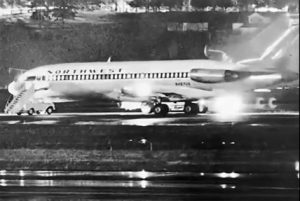 Airplane hijacking isn’t a new thing in our day and age, and usually the hijacker is extremely dangerous and often has plans to crash the plane, but there have been, in times past, some hijackings that weren’t “so bad” in the grand scheme of airplane hijacking, anyway. Sometimes the hijacker really just wanted to use the plane to get them where they wanted to go, planning to release the hostages upon arrival. Of course, hijacking isn’t really a good way to get to your vacation destination, or any other reason for your travel, because you are likely to get shot or arrested for your seemingly innocent attempts.
Airplane hijacking isn’t a new thing in our day and age, and usually the hijacker is extremely dangerous and often has plans to crash the plane, but there have been, in times past, some hijackings that weren’t “so bad” in the grand scheme of airplane hijacking, anyway. Sometimes the hijacker really just wanted to use the plane to get them where they wanted to go, planning to release the hostages upon arrival. Of course, hijacking isn’t really a good way to get to your vacation destination, or any other reason for your travel, because you are likely to get shot or arrested for your seemingly innocent attempts.
Nevertheless, on November 24, 1971, a hijacker calling himself D.B. Cooper commandeered a Northwest Orient Airlines 727 shortly after takeoff. He showed a flight attendant something that looked like a bomb, and informed the crew that he wanted $200,000, four parachutes, and “no funny stuff.” The plane landed at Seattle-Tacoma International Airport, where authorities met Cooper’s demands, which was common back then, and evacuated most of the passengers. Cooper then demanded that the plane fly toward Mexico at a low altitude and ordered the remaining crew members into the cockpit. At 8:13 pm, as the plane flew over the 
 Lewis River in southwest Washington, Cooper parachuted from the plane. The airplane’s pressure gauge recorded the jump. Wearing only wrap-around sunglasses, a thin suit, and a raincoat, Cooper parachuted into a thunderstorm, with winds in excess of 100 mph and temperatures well below zero at the 10,000 foot altitude where he began his fall. The storm prevented an immediate capture, and most authorities assumed he was killed during what they deemed a suicidal jump. No trace of Cooper has ever been found, despite a massive search of the area, and FBI posters, with age analysis.
Lewis River in southwest Washington, Cooper parachuted from the plane. The airplane’s pressure gauge recorded the jump. Wearing only wrap-around sunglasses, a thin suit, and a raincoat, Cooper parachuted into a thunderstorm, with winds in excess of 100 mph and temperatures well below zero at the 10,000 foot altitude where he began his fall. The storm prevented an immediate capture, and most authorities assumed he was killed during what they deemed a suicidal jump. No trace of Cooper has ever been found, despite a massive search of the area, and FBI posters, with age analysis.
In 1980, an eight year old boy uncovered a stack of nearly $5,880 of the ransom money in the sands along the north bank of the Columbia River, five miles from Vancouver, Washington. There was no trace of Cooper’s remains in the area. The money was given back to the boy, and he sold some of the bills as souvenirs. No more of the money has ever been found, on the ground or in circulation. More than four decades later, three amateur scientists working for a group called Citizen Sleuths, think they may have found evidence that would narrow down Cooper’s identity. They believe that he had to be an aerospace engineer or a manager. The scientists said they have been analyzing particles found on a clip-on necktie that Cooper left on his seat…number 18E…before 
 jumping out of the plane. To the naked eye, the piece of fabric was a nondescript black tie from J.C. Penney. But, to the modern-day scientists, the tie was an “incredibly fortunate” piece of evidence in the investigation, because ties are not washed often, so DNA could remain on the tie, and with modern DNA testing, maybe they will be able to figure out who D.B. Cooper really was.
jumping out of the plane. To the naked eye, the piece of fabric was a nondescript black tie from J.C. Penney. But, to the modern-day scientists, the tie was an “incredibly fortunate” piece of evidence in the investigation, because ties are not washed often, so DNA could remain on the tie, and with modern DNA testing, maybe they will be able to figure out who D.B. Cooper really was.

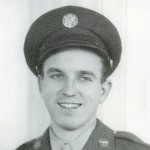 The mind of a soldier, in any branch of the service, is a mind that many of us do not understand. They go into situations that would send most of us running for the nearest hole to hide in, and then…when they write home or call home, they make light of the things they are doing…if they tell their family about their missions at all, because they don’t want to worry their loved ones. Often, if the family finds out about the missions they were on at all, it is years later. Maybe it is that they had to wrap their own minds around the things they had done, before they could tell anyone else about it. My dad, Allen Spencer was that way. In the letters he wrote home to his family, and especially his mother, his words were always very upbeat, very careful not to say the wrong things…things that might make them fear for his life, more than they already did. My nephew, Allen Spencer Beach, my dad’s namesake, is much like his grandfather in that way.
The mind of a soldier, in any branch of the service, is a mind that many of us do not understand. They go into situations that would send most of us running for the nearest hole to hide in, and then…when they write home or call home, they make light of the things they are doing…if they tell their family about their missions at all, because they don’t want to worry their loved ones. Often, if the family finds out about the missions they were on at all, it is years later. Maybe it is that they had to wrap their own minds around the things they had done, before they could tell anyone else about it. My dad, Allen Spencer was that way. In the letters he wrote home to his family, and especially his mother, his words were always very upbeat, very careful not to say the wrong things…things that might make them fear for his life, more than they already did. My nephew, Allen Spencer Beach, my dad’s namesake, is much like his grandfather in that way.
When Allen joined the Navy in 2009, it was to be part of the Naval Air Force. Part of his training was parachuting from a plane. At some point in his training, Allen injured his foot, and while the injury itself would not have stopped him from continuing in his chosen field, it delayed training long enough so that he wouldn’t be able to catch up with his class. It was at this point that Allen decided to become a medic. All of that information was known to most of his family at that time. It was certain parts of Allen’s work after that time that was only known to his family a number of years later. After the 7.0 earthquake that occurred in Haiti on January 12, 2010, Allen was one of the soldiers who was sent in to assist. I think most of us saw pictures of the devastation there, and the loss of life, but I seriously doubt that the news media showed us some of the worst parts of the devastation. It would be too much for many people to bare. I’m sure that is why Allen, like his grandfather, couldn’t tell his mother everything he did or saw. He had to process it himself, and put enough time between the event and his mother’s knowledge of it, so that hopefully she would not worry too much. I also have to wonder if his experience in Haiti is what made him decide to become a medic after his foot injury.
My sister, Caryl Reed, also found out, after the fact, that at one point, her son, Allen was training to be a medic for the Marines. Had he been needed, Allen would have become a medic on the front lines in a war zone. Here again, Allen knew that there needed to be enough time between the event and his mother’s knowledge of it, so she would not have nightmares. When she found out about that, all my sister could think was, “Thank the Lord that he didn’t have to go.” It was a mother’s second worst nightmares…the first being that her son actually goes to the front lines. A soldier has to push their own fear down as deep as they can, and make light of things with their loved ones, because they can imagine the anguish for their family, if they knew that truth…that they 
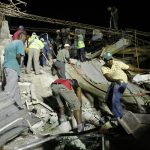 are in situations that really scare them, and they have no control over it. It is the experiences we live that help us to decide the direction our life will take. For Allen, what began as a career as maybe a pilot, has changed to a career in several different areas of medicine. From corpsman, to training as a field medic, to studying to be a hospital administrator. Allen left active duty in 2014, and lives in Washington DC, while his wife, Gabby finishes her service, and he finishes his studies. I know he will have a bright future. Today is Allen’s birthday. Happy birthday Allen!! Have a great day!! We love you!!
are in situations that really scare them, and they have no control over it. It is the experiences we live that help us to decide the direction our life will take. For Allen, what began as a career as maybe a pilot, has changed to a career in several different areas of medicine. From corpsman, to training as a field medic, to studying to be a hospital administrator. Allen left active duty in 2014, and lives in Washington DC, while his wife, Gabby finishes her service, and he finishes his studies. I know he will have a bright future. Today is Allen’s birthday. Happy birthday Allen!! Have a great day!! We love you!!

